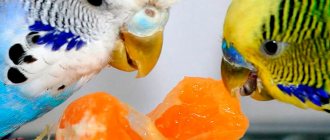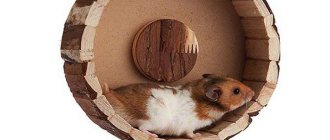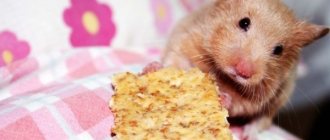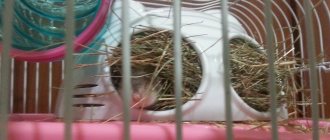- home
- Nutrition
17.07.2018
A hamster's diet may seem boring compared to the variety of flavors that other pets eat. Cats can have lamb fricassee, ocean salmon jelly, various pates, pillows, and soft bones. What do hamsters like besides the usual grain feed and vegetables? We present to your attention a list of treats that can be included in a rodent’s menu without harming its health.
What to buy to please your pet
There are always a lot of beautiful packages on the shelves of pet stores, and sellers persuade you to buy this or that treat for hamsters. However, what ready-made products are suitable for your pet, what he will eat with pleasure, and what he will refuse, depends only on him. The owner can choose treats for the hamster based on his preferences, as well as taking into account contraindications for a particular individual, breed or species.
Manufacturers do not always use exclusively healthy ingredients in their products for rodents, so make sure that your hamster does not get the following with a piece of food:
- salt;
- sugar;
- fats;
- flavorings, flavor enhancers, artificial sweeteners and other non-natural additives.
All these components are prohibited for feeding small rodents. Their use will cause poisoning, as well as malfunction of various body systems.
It is best to choose treats for your hamster that include sunflower seeds, nuts, banana chips, dried vegetables and fruits. This is the most favorite food of hamsters.
Let's take a look at what the stores offer:
- various mixtures of berries, fruits, grains, which can additionally be enriched with vitamins and various beneficial additives;
Mixes for hamsters
- grain sticks are also very diverse in their composition;
Cereal sticks for hamster
- tartlets;
Hamster tartlets
- a treat in hemp will not only serve as a tasty treat, but will also be additional entertainment for your hamster;
Treat in hemp for a hamster
- a labyrinth or house is not only edible, but also a great place where a hamster can hide and relax.
Treat house for a hamster
Prohibited Products
Some harmless products can be dangerous for both Syrian and Djungarian hamsters. List of what you should not feed them:
- food intended for parrots or other rodents;
- acorns, chestnuts, potatoes;
- cheese, lard, any products containing more than 3% fat;
- spices;
- almond;
- dairy products;
- sweets, juices;
- fatty food;
- white cabbage is dangerous and fatal;
- garlic, onion;
- chocolate;
- citrus, exotic fruits;
- seeds, seeds of any fruit;
- captured insects that are not typical for the diet of dwarf birds;
- canned, stewed, fried, smoked foods;
- butter.
The Syrian hamster has a lot of positive emotions, joy, laughter, and is not picky about food. But you need to feed him correctly, understanding that his well-being and life expectancy are influenced by proper maintenance, a balanced diet, and tender and kind feelings towards the pet.
Choosing the right diet for your pet is the key to its health and good mood. In this article, we’ll look at what to feed your Syrian hamster at home and make a list of healthy and unhealthy foods. The list will help inexperienced owners quickly navigate and create the ideal menu for the baby.
Let's also look at what can be given to a Syrian hamster, and what it should absolutely not be fed.
What to cook yourself
If you couldn’t find a decent product in the store to please the animal, you need to figure out how to make treats for your hamster with your own hands.
There are a great many options for delicious and healthy dishes for little friends. They are very easy to prepare. Here are some recipes:
- Mix banana pulp and oatmeal. Roll into balls. You can add some raisins.
- Chop well washed and dried lettuce and clover leaves, mix, add walnut kernels.
- Add egg white to the grain mixture that the rodent usually eats (beat it a little first). Form small cakes from this “dough” and bake until hardened in the oven at 30-60°C.
The ingredients for salads and “cookies” can be varied independently, taking into account the preferences of a particular animal.
In addition to such homemade treats, you can also offer your baby wheat sprouts, oats, and millet. Fresh herbs are also on the list of what hamsters love most. Growing it is not difficult: you need to take a small pot of soil, pour into it the remains of the grain mixture that the animal has not eaten, sprinkle it with soil and water it. In a few days the first shoots will appear.
How to do it yourself?
At home, anyone can make homemade interesting toys for their pet.
Crafts from nuts
You can easily make an interesting toy from walnut shells. For work you need to prepare the following items:
- nuts with whole shell;
- hammer;
- nail;
- rope;
- metal washer.
Let's look at the step-by-step execution of the work.
- Walnuts must be carefully split into two halves, but they must remain whole. You can treat your rodent to the core; such a delicacy will be not only tasty, but also healthy for him.
- Prepare a piece of rope that fits the size of the cage (consider its height). The rope must be strong.
- Using a hammer and nail, make a hole in the center of each shell.
- Tie a washer to the edge of the rope.
- Next, string the peeled nut halves onto it.
- Be sure to leave some room to securely attach the toy to the top bar of the cage.
You can improve this product if you put the animal’s favorite treats in the shell. As you can see, to manufacture the structure you need available materials and very little time.
Sleeve toy
The cardboard rolls left over from kitchen paper towels can be used to create a simple yet fun toy.
To create this craft you will need the following:
- sleeve;
- scissors;
- a piece of treat for the hamster.
Getting the job done is quite simple.
- Cut 5 rings of equal size from the tube.
- Next, you need to insert the rings into each other so that the result is a cross section. There is no need to use glue, paper clips or other connecting elements.
- We put a delicacy for the pet inside the structure and place the toy in the cage. Thus, the hamster will get to the yummy food through the cardboard rings. The pleasant and appetizing smell of the treat will attract the rodent’s attention to the craft.
What to treat the dzhungarik
Treats for the Djungarian should be selected according not only to his personal tastes, but also to the characteristics of the breed. Regardless of what Djungarian hamsters like to eat, it is strictly not recommended to give them sweets.
Some Djungarian hamsters like to eat insects (dried grasshoppers, worms) as treats, and chew twigs of permitted fruit trees. The recipes for homemade treats given above are also suitable for tiny pets, but it is recommended to give them bananas no more than once a week.
How much do hamsters eat?
Many people take hamsters as pets because they are cute "cheek stuffers." The problem is that they quickly gain fat and this shortens the life of the rodent. Therefore, please read the feeding recommendations below carefully.
Measure portions correctly!
The hamster is a nocturnal animal. In the evening he has “breakfast”, which should be the main meal of the day. Many people give food to their pet only in the evening, and there is no mistake in this, but it can be divided into 2 times (give the smaller portion in the morning).
It’s difficult to say how much food a hamster needs every day, it depends on:
- Hamster breeds
- Sizes
- Health conditions
- Amount of physical activity
When using ready-made mixtures, we recommend feeding in the following portions (these are average values): the daily food intake should be 2/3 of the hamster’s weight. Those. a hamster weighing 100 g should consume no more than 70 g of food.
Tips and tricks
Choosing treats for hamsters is a pleasure for their owners. However, we must not forget that treats should be given in limited quantities, only for reward during training or for entertainment.
It is unacceptable to replace the main diet with delicacies!
Do not offer your animal goodies from your table - he should not eat chocolate, sweet pastries or sausage. Such foods will greatly harm his health.
Canned vegetables and fruits, as well as food intended for other animals, are also not the best choice.
If you buy special sticks and drops for rodents, carefully study the composition.
Manufacturers know what hamsters love to eat and include the most delicious ingredients in their products, but they often add harmful ingredients designed to preserve the delicacy longer or enhance its smell.
Do not give your baby a lot of unfamiliar treats at once - first offer the animal a small piece and monitor its behavior. If the animal behaves as usual for several hours, feel free to put a larger portion in the cage.
Remove stored treats from your pet's pantries more often. The pieces may spoil and cause poisoning.
Source
When to feed your hamster
Hamsters are nocturnal animals, so you need to feed them in the evening. In the morning, you can offer a small amount of low-calorie food, such as fruits or vegetables.
Hamsters are prone to obesity and diabetes. This greatly reduces the animal's lifespan. Therefore, watch the quantity and quality of food. Everything that the hamster does not eat here and now, the thrifty rodent will definitely take to his pantry.
The rodent's pantry must be emptied periodically. To prevent your pet from getting upset, offer him some kind of treat in return. If food supplies are not removed from the cage, over time they will begin to deteriorate and rot.
Not only the pet’s health and activity, but also its life expectancy depends on proper and balanced nutrition. It is also important to monitor the quality of food and not to overfeed the hamster.
What hamsters like to eat: a review of treats and treats
A hamster's diet may seem boring compared to the variety of flavors that other pets eat. Cats can have lamb fricassee, ocean salmon jelly, various pates, pillows, and soft bones. What do hamsters like besides the usual grain feed and vegetables? We present to your attention a list of treats that can be included in a rodent’s menu without harming its health.
Peculiarities
In natural conditions, rodents are constantly moving. In this way they protect themselves from predators and look for food. Hamsters living indoors must also constantly move to maintain physical fitness. An active lifestyle is also necessary for the excellent mood of pets.
The animal must have several toys. The cost of some of them can be high, in this case you can collect available materials and please your pet with interesting crafts. The number of toys can be any, the main thing is that there is enough free space in the cage. It is best to make several different products.
Treats from the pet store
The pet industry has not neglected representatives of the genus of rodents - hamsters. On the shelves of specialized stores you can find various treats for little furries:
- Fruit and nut mixtures in jars or bags. Consist of dried fruits, berries, seeds, nuts and cereals.
- Cereal bars. They come with the addition of vegetables or fruits.
- Tartlets with various fillings.
- Volumetric structures made of cereals and fruits that a pet can use as a house, nest or labyrinth.
- Cookies, biscuits, crispy sticks for hamsters.
These products can be found at your local pet store along with regular food. Despite the fact that the packaging states that the product is designed specifically for rodents, you should not trust the bright label. Be sure to read the composition of the food. Hamster food should not contain sugar, yeast, dyes or flavors; it is advisable to avoid preservatives, stabilizers and unknown components.
For example, the composition of one of the products found among treats for hamsters: cereals, cereals, egg and its derivatives (30%), sugar (27%), carrots/berries (4.1%), dyes and preservatives in accordance with EEC standards . A large amount of sugar among the components is very harmful to the rodent and can provoke various diseases. Dyes and preservatives can cause allergies and cause cancer. Even if it is said that they meet the standards.
Try to choose a treat consisting of natural ingredients, for example: premium green hay "Lux", dried fruits and vegetables (apples, pumpkin, carrots), millet, sunflower seeds, wheat, oats and corn.
Homemade desserts
To ensure that the composition of the delicacy does not raise doubts and concerns, you can prepare the delicacies with your own hands. Let's create a dessert menu based on the foods that hamsters love to eat:
- muesli - cereal flakes mixed with a banana, grated apple or carrot, can be rolled into balls or formed into mini bars;
- cookies - mix whipped egg whites with a grain mixture or cereal flakes, bake like regular cookies;
- salad - add pine nut kernels to green leaves, serve as a salad;
- kebab - string pieces of sweet pepper, carrot, apple onto a twig or toothpick (after cutting off the sharp ends).
Prohibited Products
There is an opinion among inexperienced owners that hamsters of other breeds can eat this or that food, but not Syrian ones. In fact, this assumption is not true and the list of prohibited products applies to representatives of all varieties.
Hamsters are contraindicated to eat:
- chocolate;
- mushrooms;
- canned food;
- fruit seeds;
- milk;
- citrus;
- bakery products;
- pine needles;
- cabbage;
- sorrel, lingonberry, sea buckthorn and other plants with essential oils;
- feed for other animals and birds;
- fatty, salty, spicy and sweet foods.
Treats for different breeds
Like people of different nationalities, hamsters of different breeds have their own taste preferences.
Favorite food for the dwarf is nuts, branches of fruit trees and bamboo shoots. The hamster will happily gnaw on apple, plum or currant twigs peeled from the bark, and his teeth will be healthy and clean.
Syrian hamsters love greens the most. This could be parsley, dandelion leaves, clover, or regular lettuce. In winter, you can sprout grains from food or buy ready-made grass in the store. Grass brought from the street should be thoroughly washed with water to remove dust and dirt.
Campbell's hamster is a big fan of pumpkin and sunflower seeds. He also likes to eat boiled liver, but you can give it no more than once every 2 weeks.
General recommendations
When choosing a treat for a small pet, you should consider several rules:
- Sugar and honey are contraindicated for hamsters;
- Do not give nuts and crackers containing salt and flavoring additives;
- When choosing a treat in a store, always study the composition, giving preference to natural, without additives;
- prepare a treat from familiar foods;
- When offering a treat for the first time, give a small portion to test the body’s reaction;
- dessert should not replace a meal; if you offer a treat too often, your pet will get used to it and will no longer be so happy when receiving a reward.
It is very important to remember to remove any remaining spoilage food from the feeder and pantry. After three days, the apple given to the hamster will no longer be a dessert and can cause digestive problems.
Source
What hamsters like to eat: a review of treats and treats
Proper, nutritious nutrition is an integral part of caring for a hamster. Feeding plays an important role in the growth, development and maintenance of animal health. It is necessary to give only products approved for animals. Sometimes owners think about how to reward their pet. Let's figure out what hamsters love, what treats to please your pet with, and how to make a treat yourself.
What to buy to please your pet
Pet stores offer a wide range of treats for hamsters. But you shouldn’t take the first product you come across. Carefully study the composition of the product before purchasing. Unscrupulous manufacturers add ingredients that are harmful and even dangerous to animals. The treat should not contain: salt, sugar, fats, artificial additives (flavors, dyes, taste enhancers). Consider your pet's breed when choosing treats. For example, some foods allowed for Syrians are not suitable for Djungarians.
If the product contains prohibited components, the hamster may be poisoned. The functioning of the digestive tract will also be disrupted, which will negatively affect the condition of the animal.
What to cook yourself
If you couldn’t find a suitable product in the store’s assortment, you can prepare the treat yourself.
There are many simple recipes for healthy and tasty dishes for hamsters. Some of the most popular are the following recipes.
- Mix banana pulp with oatmeal. Form into balls. Additionally, you can add some raisins.
- Chop fresh, washed greens (for example, lettuce, chrysanthemum, clover). Mix greens with walnuts.
- Combine the grain mixture with the beaten egg white. Make small pancakes from the resulting dough and bake until hardened in the oven.
Create treats based on your pet's preferences. Select the necessary ingredients and their quantity for each individual separately.
Animals also love to eat sprouted seeds of wheat, millet and oats. Fresh greens are one of the favorite treats of rodents. You can grow your own grass. Take a small pot, fill it with soil and add a few seeds or leftover grain mixture. Sprinkle with soil and water. Shoots will appear a few days after planting.
What to treat the dzhungarik
You should select treats for dzhungarikas, guided not only by the taste preferences of the rodent. It is not recommended to give dwarfs to eat sweets.
Treat your pet to insects (for example, dried grasshoppers or worms), branches of fruit trees. Be sure to read the list of permitted trees and feeding rules.
The recipes for homemade treats described above are suitable for feeding small Djungarian hamsters. Note that bananas should be given once every 7 days.
Varieties
All toys that are chosen for pet rodents are aimed at two tasks:
- search for treats;
- encouragement to move and be active.
In some products, these two purposes can be successfully combined. It is worth noting that the treat for the hamster is safely hidden. To get to a tasty treat, you need to go through a maze or cope with a tricky structure. The smell of food is an additional incentive to go through the maze or perform other actions.
Other products that do not hide food are considered exercise equipment. The most common toy of this type is the running wheel.











